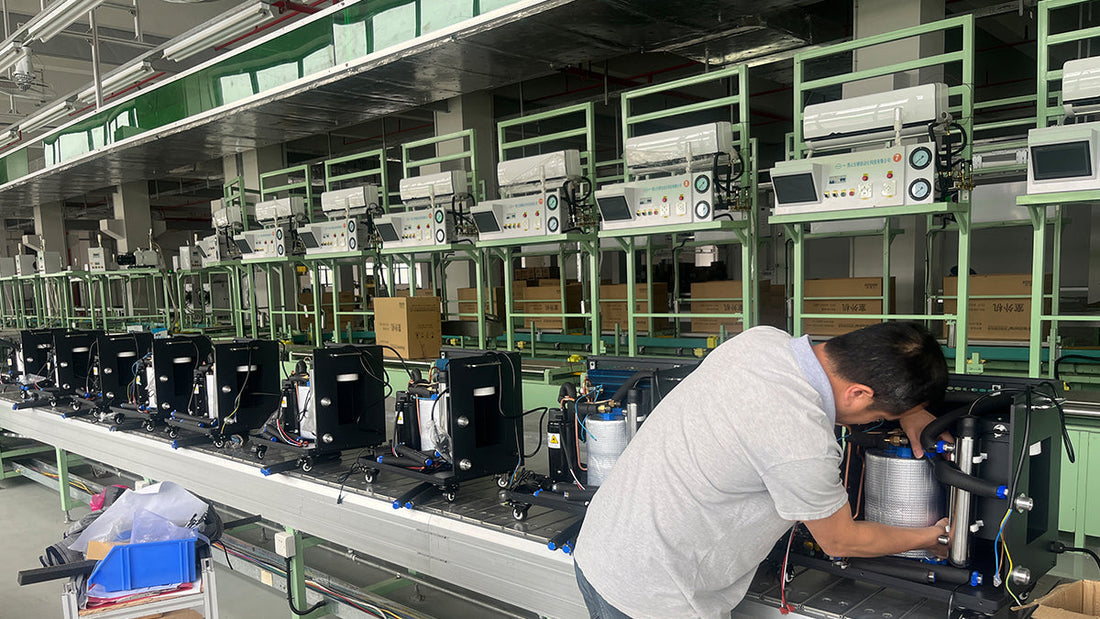
Ice bath chillers, also known as cold plunge chillers, play a crucial role in maintaining precise and efficient cooling in recovery systems, spas, and high-performance athletic facilities. Understanding how an ice bath chiller operates can help optimize performance and ensure long-term reliability. This article explores the core principles of ice bath chiller operation, focusing on the refrigeration cycle, types of compressors, expansion valves, and cooling methods.
Diagram: The Refrigeration Cycle in a Chiller

This diagram illustrates the continuous loop of the refrigeration cycle, highlighting the key components and their roles in the cooling process. By mastering these concepts, one can not only operate chillers more effectively but also troubleshoot and optimize their performance, ensuring reliable and efficient cooling for years to come.
The Refrigeration Cycle: The Heart of Ice Bath Chiller Operation
At the core of every ice bath chiller is the refrigeration cycle, which removes heat from water through a vapor-compression system. This cycle enables the chiller to maintain a consistently low water temperature for optimal cold therapy.
1. Evaporation:
The cycle begins with the evaporator, where the refrigerant absorbs heat from the water in the ice bath, causing the refrigerant to evaporate. This phase change from liquid to gas is crucial, as it is where the actual cooling takes place. The now-chilled water is then circulated back into the ice bath.

2. Compression:
The gaseous refrigerant moves to the compressor, which increases its pressure and temperature. This step is vital as it prepares the refrigerant to release the absorbed heat in the next stage.

3. Condensation:
The high-pressure, high-temperature refrigerant gas then enters the condenser, where it releases its heat to the cooling medium (typically air or water). The refrigerant condenses back into a liquid, allowing the cycle to continue.

4. Expansion:
Finally, the high-pressure liquid refrigerant passes through an expansion valve, where its pressure and temperature drop significantly, preparing it to re-enter the evaporator and repeat the cycle.

Types of Compressors: The Driving Force Behind Ice Bath Chillers
Compressors play a crucial role in the refrigeration cycle by pressurizing the refrigerant. Several types of compressors are commonly used in ice bath chillers:
1. Reciprocating Compressors:
These compressors use pistons driven by a crankshaft to compress the refrigerant. They are known for their durability and efficiency in small to medium-sized chillers. However, they can be noisy and require regular maintenance.
2. Scroll Compressors:
Scroll compressors use two spiral-shaped scrolls—one fixed and one moving—to compress the refrigerant. They are quieter, have fewer moving parts, and require less maintenance compared to reciprocating compressors.
Hi-Q Therapy ice bath chillers utilize scroll compressors, which offer high efficiency, reliability, and low noise levels, making them ideal for recovery and wellness applications.

3. Screw Compressors:
Screw compressors utilize two meshing helical screws to compress the refrigerant. They are highly efficient and suitable for larger chillers, particularly in applications with fluctuating cooling demands.
4. Centrifugal Compressors:
Centrifugal compressors use a rotating impeller to increase the refrigerant's velocity, converting it into pressure. These compressors are highly efficient and ideal for large-capacity chillers.
Types of Expansion Valves: Regulating Refrigerant Flow
Expansion valves control the amount of refrigerant entering the evaporator, ensuring efficient operation and stable cooling performance. The main types of expansion valves include:
1. Thermostatic Expansion Valves (TXV):
TXVs regulate the flow of refrigerant based on superheat levels. They are commonly used in traditional chiller systems and provide reliable performance in maintaining cooling efficiency.
2. Electronic Expansion Valves (EEV):
EEVs use electronic sensors and microprocessors to precisely control refrigerant flow. They respond quickly to changing cooling demands, improving energy efficiency and temperature stability.
Hi-Q Therapy cold plunge chillers incorporate electronic expansion valves, allowing for precise refrigerant control and optimized cooling efficiency in various operating conditions.

The Cooling System: Ensuring Efficient Heat Dissipation
Ice bath chillers rely on an effective cooling system to dissipate heat absorbed from the water. There are two primary types of cooling systems:
1. Air-Cooled Systems:
Air-cooled chillers use fans to dissipate heat from the refrigerant through condenser coils. These systems are easier to install and require less maintenance, making them suitable for smaller applications or locations where water is scarce.
2. Water-Cooled Systems:
Water-cooled chillers use water as a heat exchange medium, typically requiring a cooling tower. These systems are more efficient for large-scale applications but require additional infrastructure and water resources. Hi-Q Therapy water chillers use water-cooled condensers, which simplify installation and maintenance while ensuring efficient heat dissipation.

Precise Temperature Control: Achieving Optimal Cooling Performance
Maintaining a stable and precise water temperature is critical for cold therapy applications. Advanced control systems ensure efficient operation, including:
1. Smart Control Systems:
Hi ice bath chillers integrate WiFi-enabled smart controllers, allowing users to adjust temperature settings remotely, set timers, and monitor real-time performance via mobile apps.

2. Variable Speed Technology:
By adjusting the compressor’s speed according to the cooling demand, variable speed drives (VSDs) enhance energy efficiency while maintaining precise temperature stability.
Conclusion
Ice bath chillers are sophisticated machines designed to deliver precise and efficient cooling for recovery and wellness applications. Understanding the refrigeration cycle allows users to maximize performance and longevity.
If you are looking for a professional ice bath chiller supplier, welcome to contact Hi-Q Therapy for enquiry. Email Andre@hi-qtech.com
Hi-Q Group- The Global Leading Ice Bath Chiller Manufacturer !
